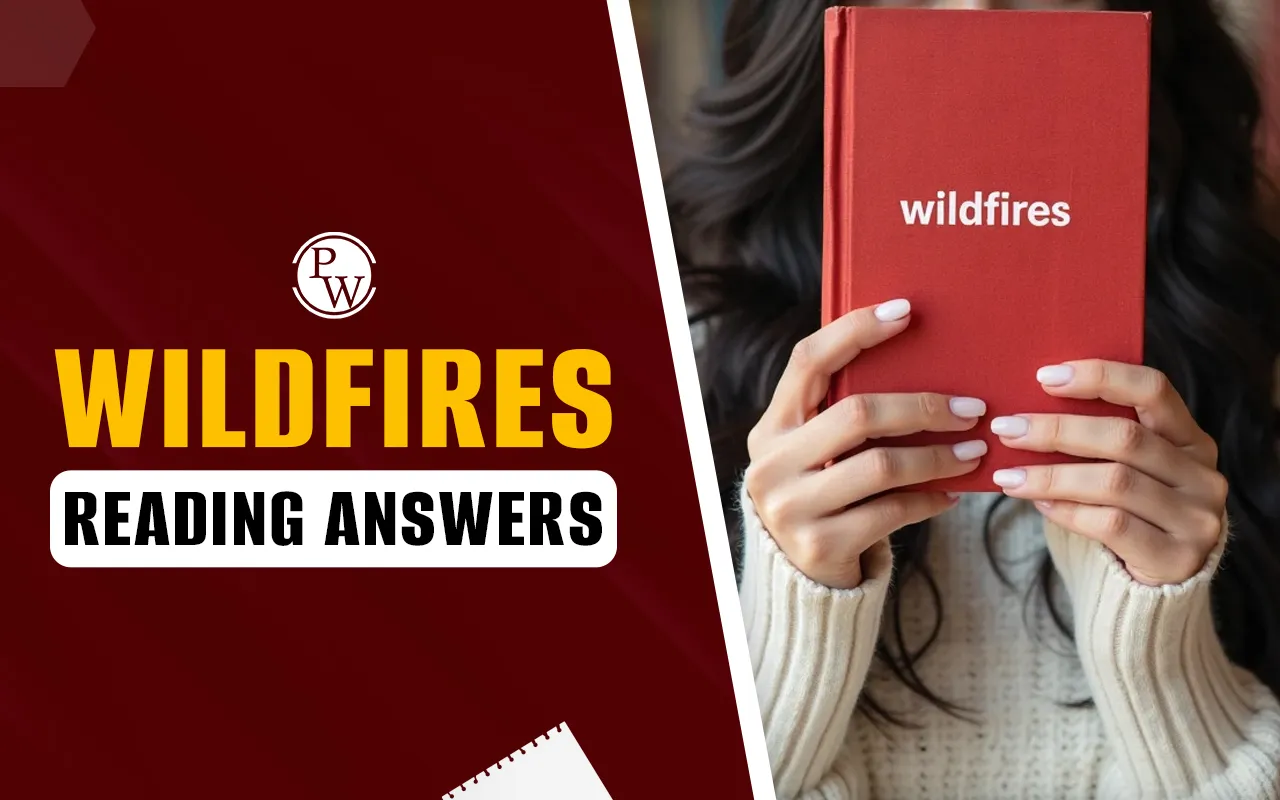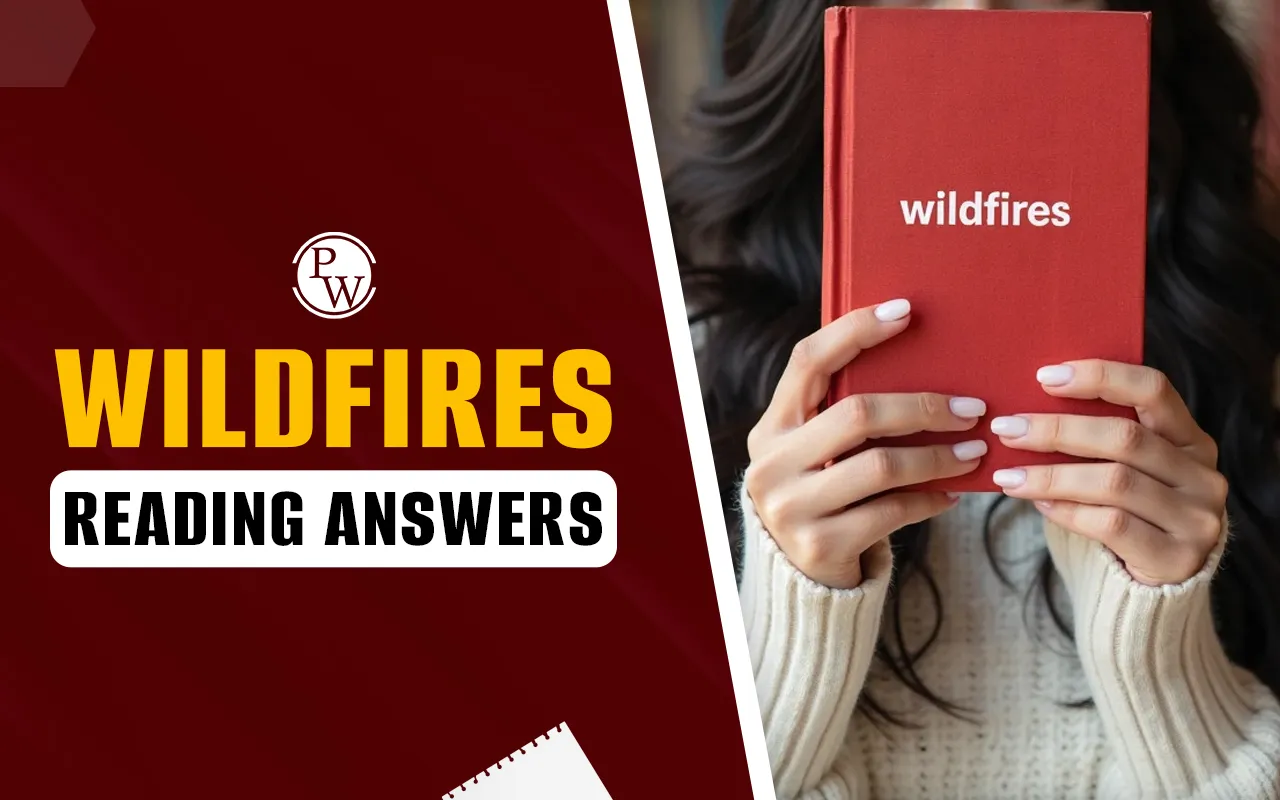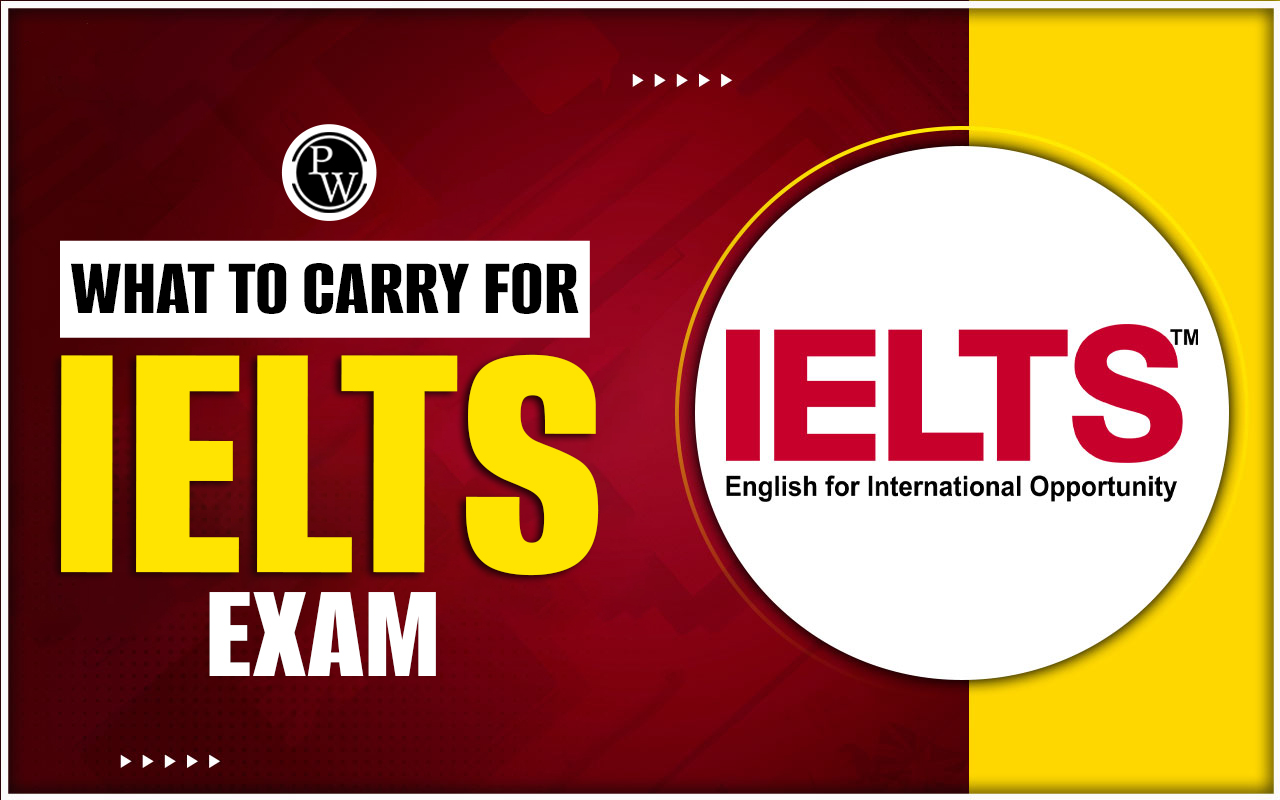

Wildfires Reading Answers: The IELTS Reading passage “Wildfires” is an important topic that tests a candidate's ability to comprehend scientific explanations and environmental phenomena. This passage includes various question types such as Matching Headings, Short Answer Questions, and Sentence Completion, helping students enhance their reading skills and time management for the exam. By practicing with this passage, test-takers can familiarize themselves with complex vocabulary, cause-and-effect relationships, and key details related to wildfires, including their causes, behavior, and firefighting techniques. Regular practice with Wildfires Reading Answers will not only improve accuracy but also boost confidence in tackling the IELTS Reading section effectively.
Wildfires Reading Answers Passage
You should spend about 20 minutes on Questions 1—13, which are based on the Reading Passage below.
Wildfires
- Human negligence is often the cause of wildfires. Approximately 90% of wildfires are ignited by humans, and the remaining 10% are caused by lightning. Some of the most frequent and common reasons for these fires are arson, camping fires, lit cigarettes, fireworks, playing with matchsticks, and burning garbage. Once a wildfire has been ignited, it can spread at a speed of 23 kph, and as it spreads across the landscape, it could kill one of its own or do anything that can help keep itself going, as far as starting fires miles away by chucking cinders.
A fire needs three elements to ignite: fuel, oxygen, and heat. These three components create the fire triangle, and they are often spoken about by firefighters while attempting to put out the fire. According to the concept, if one of the three elements is removed, the firefighters would have control over the fire and thus, finally, extinguish the fire. - The fuel in the area surrounding the fires determines the speed at which they spread. Anything that is alive or dead and has the ability to burn is fuel. There are different types of fuel, which include everything — that is, houses, trees, grasslands, and underbrush. The amount of inflammable matter surrounding the fire is referred to as "the fuel load" and is based on the amount of fuel that is readily available per unit area, often tonnes per acre. The amount of dryness in the fuel will also influence how the fire behaves. When the fuel is extremely dry, it burns considerably faster and starts fires that are significantly more difficult to extinguish. Size, shape, arrangement, and moisture are the primary fuel features that affect a fire. However, since wildfire fuel generally consists of the same material, the ratio of the fuel's total surface area to its volume has a large influence on the igniting time. A twig burns quickly because its surface area is not considerably larger than its volume. However, a tree requires longer to heat up before burning since its surface area is much smaller than its volume.
- Temperature, wind, and moisture are three aspects of the weather that influence wildfires. Since heat is one of the three components of the fire triangle, the temperature has a direct impact on how wildfires start. The sun heats and dries the ground's underbrush, trees, and sticks, which are all probable fuel sources. Hot temperatures accelerate the spread of a wildfire by allowing fuels to spark and burn very quickly. Therefore, wildfires tend to flare up in the afternoon, when temperatures are the highest.
The wind is probably the most unexpected component and has the biggest impact on wildfires. Winds help wildfires grow rapidly and provide access to more dry fuel and extra oxygen. In addition, fires generate winds of their own, which can be at least ten times stronger than the ambient wind. Winds can also scatter embers capable of igniting more fires; this phenomenon is known as "spotting". Winds may also alter the course of a fire, and gusts can drive flames into trees, causing a "crown fire." Humidity and rain provide moisture that can slow down and lower the intensity of fires because high moisture levels make it difficult for materials to burn. Higher humidity levels lead to fewer wildfires. - The topography can also have a major impact on wildfire behavior. Since topography rarely fluctuates over time, unlike fuel and weather, it will either help or hinder the growth of a wildfire. The slope is the primary topographical feature that affects wildfires. Fires usually spread faster uphill than downhill, and the steeper the slope, the faster it spread. This is because fires travel in the same direction as the wind, which mostly blows upward. Furthermore, the fire can warm fuel more quickly when smoke and heat travel in that direction. In comparison, the fire has to work incredibly hard to go down a hill after reaching its peak.
- Countless firefighters risk their lives while doing their jobs every year. There are two types of elite firefighters: hotshots and smokejumpers. The main duty of hotshots, who operate in 20-man groups, is to build firebreaks around fires. A land strip without any potential fuel is termed a firebreak. Smokejumpers, as their name indicates, jump from planes to smaller fires burning in inaccessible locations. They try to put out these minor fires before they escalate into big ones. In addition to creating firebreaks and spraying water and fire extinguishers on wildfires, firefighters also utilize "backfires." Firefighters initiate backfires, which burn in the direction of the central fire, consuming all potential fuel in their path. Firefighters on the ground also get a significant amount of support from the air. Tankers drop hundreds of gallons of water and extinguishers on the fire. Fire retardant, which is dumped from planes and helicopters, is a red chemical consisting of phosphate fertilizers that slow and cools the fire.
| IELTS Exam Important Links | |
|---|---|
| IELTS Reading Band Score | IELTS Listening Band Score |
| IELTS Speaking Band Score | IELTS Writing Band Score |
Wildfires Reading Answers Sample Questions
IELTS Reading Matching Headings (Q. 1-4)
Match each paragraph with the correct heading from the list below.
List of Headings:
I. The role of human activities in wildfires
II. Elements necessary for a fire to ignite
III. The effect of weather conditions on wildfires
IV. How fuel influences fire behavior
V. The impact of landscape on wildfire movement
VI. The role of firefighters in controlling wildfires
VII. How backfires help in wildfire management
-
Paragraph 1 ______
-
Paragraph 2 ______
-
Paragraph 3 ______
-
Paragraph 4 ______
IELTS Reading Short Answer Questions (Q. 5-9)
Answer the following questions using NO MORE THAN TWO WORDS AND/OR A NUMBER from the passage.
-
What percentage of wildfires are caused by humans?
-
What is another term for the amount of dry material available per unit area?
-
What factor is considered the most unpredictable in the spread of wildfires?
-
What is the term used when embers create new fires away from the main fire?
-
What type of chemical do aircraft drop to slow down wildfires?
IELTS Reading Sentence Completion (Q. 10-13)
Complete the sentences using NO MORE THAN TWO WORDS from the passage.
-
A fire requires fuel, oxygen, and heat, which together form the ______.
-
Fires move more rapidly when spreading ______.
-
When strong winds push flames into treetops, it creates a ______.
-
Firefighters use ______ to clear land and stop wildfires from spreading.
Wildfires Reading Answers with Explanations
-
I. The role of human activities in wildfires
-
Answer Location: "Approximately 90% of wildfires are ignited by humans, and the remaining 10% are caused by lightning..."
-
Explanation: The first paragraph describes how human negligence, such as arson, campfires, and fireworks, is responsible for most wildfires.
-
II. Elements necessary for a fire to ignite
-
Answer Location: "A fire needs three elements to ignite: fuel, oxygen, and heat. These three components create the fire triangle..."
-
Explanation: This paragraph explains the "fire triangle" concept, detailing the three essential elements required for a fire to start.
-
IV. How fuel influences fire behavior
-
Answer Location: "The fuel in the area surrounding the fires determines the speed at which they spread..."
-
Explanation: This paragraph discusses how different types of fuel, their dryness, size, and shape, affect the intensity and spread of wildfires.
-
III. The effect of weather conditions on wildfires
-
Answer Location: "Temperature, wind, and moisture are three aspects of the weather that influence wildfires..."
-
Explanation: This paragraph explains how weather conditions such as temperature, wind, and humidity impact the spread and intensity of wildfires.
-
90%
-
Answer Location: "Approximately 90% of wildfires are ignited by humans..."
-
Explanation: The passage states that human activities cause 90% of wildfires.
-
Fuel load
-
Answer Location: "The amount of inflammable matter surrounding the fire is referred to as 'the fuel load'..."
-
Explanation: The term "fuel load" is used to describe the amount of dry material that fuels a wildfire.
-
Wind
-
Answer Location: "The wind is probably the most unexpected component and has the biggest impact on wildfires..."
-
Explanation: The passage highlights wind as the most unpredictable factor in the spread of wildfires.
-
Spotting
-
Answer Location: "Winds can also scatter embers capable of igniting more fires; this phenomenon is known as 'spotting'."
-
Explanation: The passage defines "spotting" as the process where embers travel and start new fires.
-
Fire retardant
-
Answer Location: "Fire retardant, which is dumped from planes and helicopters, is a red chemical consisting of phosphate fertilizers that slow and cools the fire."
-
Explanation: The passage states that planes drop fire retardants to slow down and cool wildfires.
-
Fire triangle
-
Answer Location: "A fire needs three elements to ignite: fuel, oxygen, and heat. These three components create the fire triangle..."
-
Explanation: The passage defines the combination of fuel, oxygen, and heat as the "fire triangle."
-
Uphill
-
Answer Location: "Fires usually spread faster uphill than downhill, and the steeper the slope, the faster it spreads."
-
Explanation: The passage states that wildfires spread more rapidly when moving uphill.
-
Crown fire
-
Answer Location: "Gusts can drive flames into trees, causing a 'crown fire'."
-
Explanation: The passage explains that when flames reach treetops, the fire is called a "crown fire."
-
Firebreaks
-
Answer Location: "A land strip without any potential fuel is termed a firebreak."
-
Explanation: The passage defines "firebreaks" as cleared land areas that help stop wildfires from spreading.
Also Read:
- Should You Use All Capital Letters in the IELTS Listening and Reading Tests
- IELTS Reading Mistakes
- How to Improve IELTS Reading Score
- How to Manage Time in IELTS Reading
Guidance of PW IELTS
Physics Wallah offers multiple online IELTS courses for all students. Follow the IELTS pages to better prepare for the exam.
| What is IELTS Exam? | Documents Required for IELTS Registration |
| IELTS exam eligibility requirements | IELTS Exam Fees |
| IELTS test results | IELTS Exam Pattern |
Wildfires Reading Answers FAQs
What are the main causes of wildfires?
What is the fire triangle?
How does wind affect wildfires?
Why do wildfires spread faster uphill?
How do firefighters control wildfires?












